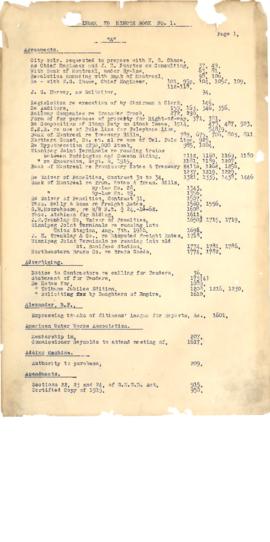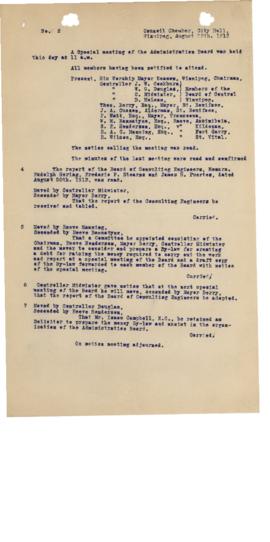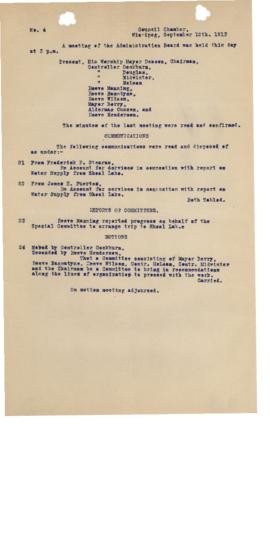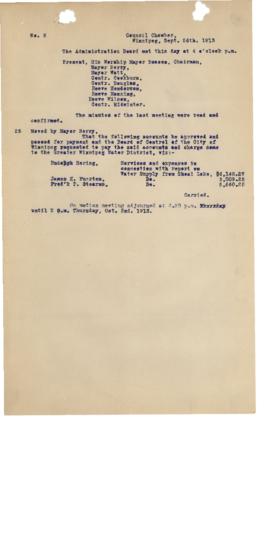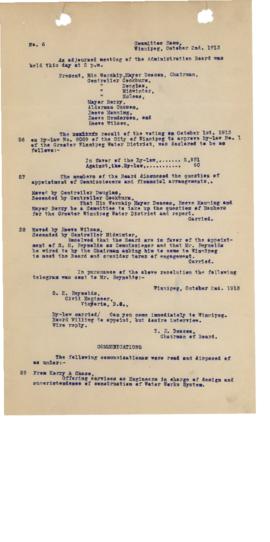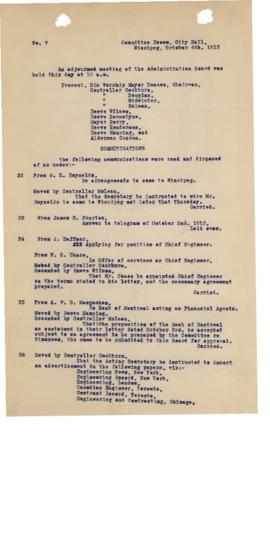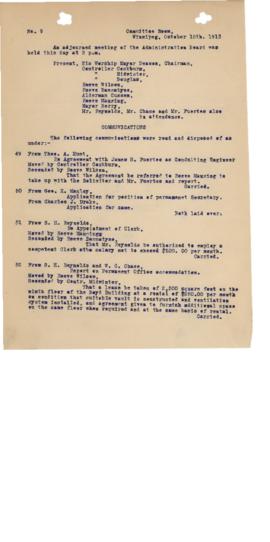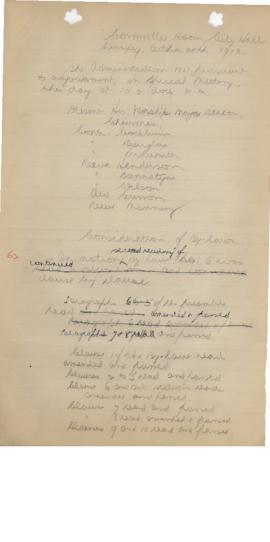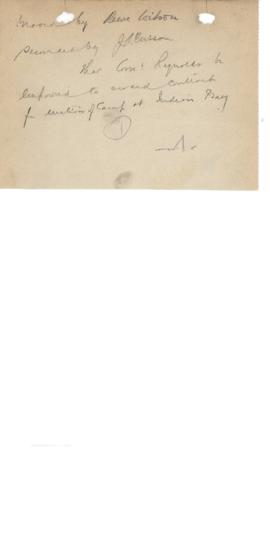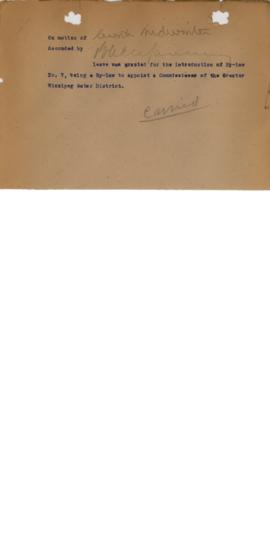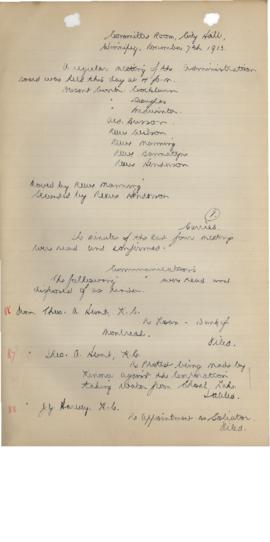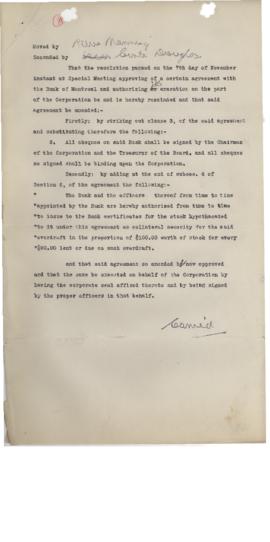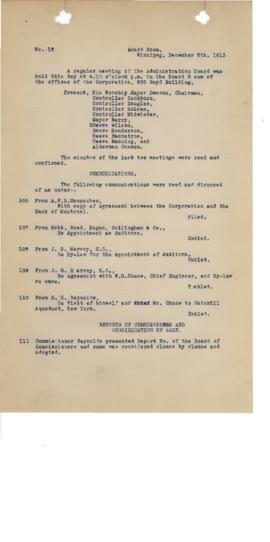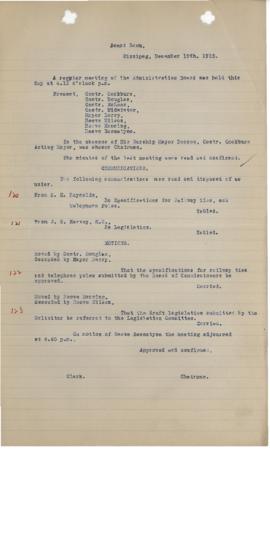Title and statement of responsibility area
Title proper
Greater Winnipeg Water District fonds
General material designation
- Multiple media
Parallel title
Other title information
Title statements of responsibility
Title notes
Level of description
Fonds
Repository
Reference code
Edition area
Edition statement
Edition statement of responsibility
Class of material specific details area
Statement of scale (cartographic)
Statement of projection (cartographic)
Statement of coordinates (cartographic)
Statement of scale (architectural)
Issuing jurisdiction and denomination (philatelic)
Dates of creation area
Date(s)
Physical description area
Physical description
Ca. 20 m of textual records and other material
Publisher's series area
Title proper of publisher's series
Parallel titles of publisher's series
Other title information of publisher's series
Statement of responsibility relating to publisher's series
Numbering within publisher's series
Note on publisher's series
Archival description area
Name of creator
Administrative history
The Greater Winnipeg Water District (GWWD) was incorporated in 1913 to supply water to the City of Winnipeg and surrounding municipalities. In May 1914, construction began on the aqueduct to bring water from Shoal Lake to Winnipeg. In March 1919, water from Shoal Lake flowed into Winnipeg’s taps and on September 9, 1919, His Royal Highness The Prince of Wales (The Prince Edward) dedicated the aqueduct. In 1935, the Greater Winnipeg Sanitary District (GWSD) was incorporated to manage wastewater collection and treatment for the participating sections of the GWWD. These two corporations existed until 1961, when their functions were taken over by the Metropolitan Corporation of Greater Winnipeg.
The GWWD was originally comprised of the City of Winnipeg, the City of St. Boniface, the Town of Transcona, the Rural Municipality of St. Vital, and parts of Fort Garry, Assiniboia, and Kildonan. By 1960, the area serviced by the GWWD also included parts of St. James and Tuxedo.
The GWWD had two boards: the Administration Board and the Board of Commissioners. The Administration Board had the policy-making function and was originally composed of the Mayor and four Councillors of the City of Winnipeg, the Mayor and one Councillor of the City of St. Boniface, the Mayor of Transcona, and the Reeves of the four other municipalities. The Administration Board’s Chairman was the Mayor of Winnipeg. The Board of Commissioners was responsible for operations and it had up to three members. Usually, the Board of Commissioners was composed of a Chairman, Treasurer and one other Commissioner. The Chairman was the City Engineer, and the Treasurer was the Commissioner of Finance of the City of Winnipeg. The third Commissioner was appointed by the Administration Board. A Board of Equalization, appointed by the Public Utilities Commissioner, was also established to determine the assessment levied on the taxable land in each municipality.
The aqueduct was largely built by three contractors, although the GWWD tendered and administered ninety-nine contracts during construction. The three main contractors were J.H. Tremblay Co. Ltd., Thos. Kelly & Sons, and the Winnipeg Aqueduct Construction Co. Ltd.
As no roads existed along the proposed route of the aqueduct, the GWWD created and operated the Greater Winnipeg Water District Railway to run parallel to the route to facilitate the movement of materials and workers. Construction of the railway track began in 1914 and was completed in 1915. The track runs from its terminus in St. Boniface to Waugh, Manitoba near Shoal Lake. After the aqueduct was completed, the railway was also used to carry freight and passengers in an effort to reduce the costs of construction. Freight included firewood, pulpwood, poles, railway ties, ice, mail, milk, gravel and sand. Although initially only three trains ran a week, at the peak of its operation up to four trains a day hauled gravel for use as an aggregate in concrete manufacture.
The first meeting of the GWWD Administration Board took place on July 30, 1913. By the fall of 1913, active work was underway and survey parties were determining the most economical route from Shoal Lake. As the waters of Shoal Lake are part of the Lake of the Woods, which crosses the boundary into the United States, it was necessary to secure the approval of the International Joint Commission. It was also necessary to secure the consent of the Ontario Government as the boundary line between the provinces of Manitoba and Ontario passes through Indian Bay, a tributary of Shoal Lake. Further sections of the aqueduct were located on reserve land belonging to Kekekoziibii Shoal Lake 40 First Nation and the sale of this land was required. The provisions of the Indian Act allowed for reserve lands to be sold with the price of the land set by the Governor in Council and the proceeds of the sale going to the Band. The Department of Indian Affairs valued three thousand acres of Kekekoziibii Shoal Lake 40 First Nation's reserve land at fifty cents per acre. Approximately fifty-five acres on the mainland were valued at three dollars an acre. As the Falcon River ran into the proposed intake area in Indian Bay, a diversion was built so that the waters of Falcon River, which had an unwanted colour, ran into Snowshoe Bay instead. The Falcon River diversion, consisting of a 2.4 km dyke and 840 m channel, solved the problem of unwanted colouration of the water supply, but had the effect of limiting Kekekoziibii Shoal Lake 40 First Nation's access to the mainland.
The City of Winnipeg Archives acknowledges the following sources:
City of Winnipeg, compiled by the City Clerk. Municipal Manual 1955. Winnipeg: Henderson Directories, [1955].
City of Winnipeg, Water and Waste Department, “The Greater Winnipeg Water District Railway.” Last updated June 29, 2018. Available: https://www.winnipeg.ca/waterandwaste/dept/railway.stm
Ennis, David A. “Developing a Domestic Water Supply for Winnipeg from Shoal Lake and Lake of the Woods: The Greater Winnipeg Water District Aqueduct.” Master’s thesis. University of Manitoba, 2011.
Special thanks to the Water and Waste Department for supplying key details.
Custodial history
Records were held by the City Clerk’s Department and later the City of Winnipeg Archives. In 1993, a number of records with operational value were taken by the Water and Waste Department. These records were used to support the Shoal Lake Aqueduct Condition Assessment and Rehabilitation Project. To facilitate wider access to these records, Water and Waste sent them back to Archives in 2015. With the exception of glass-plate negatives and photographic prints, all GWWD records are now under the care and custody of the Archives.
Scope and content
The Greater Winnipeg Water District fonds contains the records of the GWWD Administration Board and the GWWD Board of Commissioners.
The fonds also contains some records relating to water supply prior to the incorporation of GWWD.
The fonds is arranged into six series: Minutes and Reports; Communications; Financial Reports and Information; Agreements and Contracts; By-laws; and Photographs.
Series 66: Minutes, 1914-1960
Series 67: Communications and Reports, 1912-1960
Series 68: By-laws, 1913-1960
Series 69: Agreements, and Contracts, 1914-1923
Series 70: Financial, 1914-1962
Series 175: Photographs, 1913-1919
Additional records from Water and Waste received in 2015 are available.
Notes area
Physical condition
Immediate source of acquisition
Arrangement
Fonds was condensed from 69 boxes to 54 boxes in 2019. Box numbers have changed.
Language of material
Script of material
Location of originals
Availability of other formats
Restrictions on access
Terms governing use, reproduction, and publication
Permissions may be needed in order to reproduce photographs. Researchers are responsible for observing Canadian copyright regulations.
Finding aids
Uploaded finding aid
Associated materials
Accruals
Further accruals expected.
Physical description
Includes ca. 1200 photographs, ca. 10 maps, ca. 30 technical drawings


